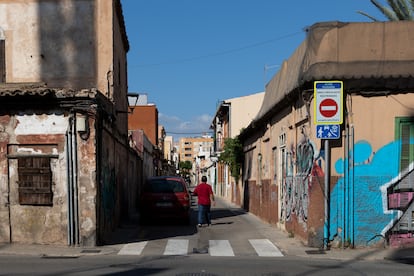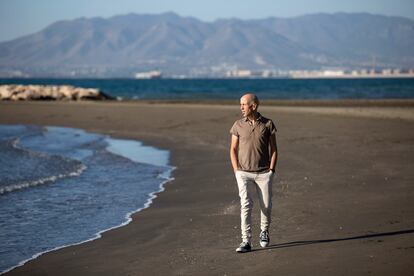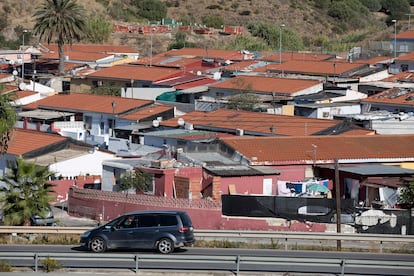How the coronavirus pandemic has widened inequalities in Spain
The health crisis has affected households with lower incomes worse than others, and has increased the already-existing gap in Spanish society

Nadia’s rental contract expired six months ago, just when the fourth wave of the coronavirus was finally coming to an end. The apartment of this 42-year-old, located in the Nou Alcolecha neighborhood in Alicante, Valencia region, was originally social housing and owned by a bank. But it has since changed hands, and its current owner, an investment fund, is calling on her to leave. “We have nowhere to go,” she complains. Rents in any other area are €350 minimum, €100 more than she is paying now.
She and her husband, both of whom are unemployed, have been on the waiting list for social housing “for the last four or five years,” but with no luck so far. The couple lives with their three children, who are aged 12, nine and seven. One of the youngsters has a disability, for which they receive benefits of €260 a month, as well as a benefit from the regional government that was given to them in recent months.
This is how they are surviving – as best as they can. “The pandemic has left all of us in a very bad situation,” she explains. “There are lots of problems in the neighborhood, people can’t find work.”
The health and economic crises have left them without options. The previous economic crisis, the so-called Great Recession, was much tougher in terms of inequality and the risk of poverty – perhaps the most worrying economic disease of these times. But the “Great Lockdown” has made the pathology chronic.
“This crisis has a number of different effects and all of them are regressive,” explains Olga Cantó, a professor of economics at Alcalá de Henares University in Madrid. “During the lockdown, the rise in extreme poverty was huge, but in the medium and long terms it’s worse: this crisis has hit when many people are just at the age when they should be stabilizing in the labor market, and that has lasting effects. We will have to wait years before we see those scars, but we will see them.”

The National Statistics Institute (INE) is yet to pass sentence, but Íñigo Macías, research coordinator for the NGO Oxfam, has no doubt that the gap between the rich and poor in Spain has widened – “and by a lot” – in the last 18 months. “This has been a cross-cutting recession, but inequality is going to rise however it is measured.”
The situation of Nadia and her family is just one of many cases of people who have seen their options for bettering their situation grind to a halt because of the coronavirus, while at the same time inequality – which is currently at the same levels of two decades ago – just gets worse.
Despite the lack of official data, all of the estimates, forecasts and studies that have been appearing in recent months unmistakably point in the same direction: despite the help from the state, which is greater than it was 10 years ago, the gap between those who have more and those who have less has been growing fast. That’s also the view of the dozen or so academics and experts consulted for this article.
Inequality in Spain grew during the final years of the 19th century and until the end of World War I. It fell during the period between the global conflicts and saw a rise during the regime of dictator Francisco Franco, according to historian Leandro Prados de la Escosura. It later fell during the 1980s, before hitting the average for the Organisation for Economic Co-operation and Development. With a few ups and downs since then, there it has stayed.
But with the two most recent crises, Spain has ended up at the top of the list in Europe in this respect, only one step below the eastern countries and the Baltics. And these high figures tend to become chronic, with more than a third of the population at risk of poverty, according to data from Brussels.
The Gini coefficient – the most-used indicator for this phenomenon – has gone up nearly 1.5 percentage points since February of last year, just before the virus shook up the stock market and everyone’s lives, according to provisional data from the research service at Spanish lender CaixaBank, and based on the analysis of three million payslips. All in all, the figure is relatively modest taking into account that during the toughest moment of the crisis the indicator went up three points.
“Several years in the battle against inequality have been lost, and what we’re seeing now is the situation become chronic: it went up a lot with the previous crisis, fell slowly afterwards and now is strongly rising once more,” explains economist José Moisés Martín Carretero, who considers women and young people to be the most affected. Juan C. Palomino, a Research Officer at the Department of Social Policy and Intervention and the Institute for New Economic Thinking (INET) at the University of Oxford, agrees. He says that the worst off are “those who were at the lower end of salary distribution.” And that’s not to mention the underground economy, which short-circuited during the lockdown leaving a considerable number of households without any income at all.
The inequality gap began to widen the very moment that the Spanish government declared the first coronavirus state of alarm, on March 14, 2020, and companies began to send their employees home. Those who were able to work from home were, in general, those who had a higher level of education, while the job losses were mostly suffered by people with fewer qualifications or training, lower salaries and in many cases temporary contracts.
This was the case of Castor Salillas, 44 and from La Rioja. On March 15 last year, his life changed. After two years sleeping on the streets of Málaga, the spring marked the one-year anniversary of his new life. He was earning enough as a warehouse worker to rent a small studio apartment, buy a simple car, pay his bills and afford to feed himself. “I could only live from day to day, but my situation was comfortable,” he explains. But that day he got a WhatsApp message: he was losing his job. For six months, including the weeks of the strict lockdown, he was bringing in just €430 a month. His anxiety and fears returned, and in January he ended up on the streets once more. “I was starting to have a dignified life and the pandemic was a massive blow,” Salillas explains. “All of my ghosts returned at once.” The social workers who helped him the first time around gave him a new challenge: if he got off the streets the first time, he could do it again. “And that’s what I’m doing, at a shelter, studying and getting ready to look for work,” he reports, with an air of optimism.
During the lockdown, when the lines at soup kitchens revealed the cracks in Spanish society and the number of households with no earnings rose to 100,000, the income of the richest 10% of society ended up being 15 times greater than the poorest 10%, according to the Bank of Spain. By the end of 2020, the gap had fallen to 8.3 times, but the central lender itself warned in its last annual report that after several years of falls in inequality in terms of work income – thanks to the job market improving in the recovery after the financial crisis – the arrival of the pandemic “changed the course of the indicators once more.” The virus, the report continues, “is going to leave deep social scars, with the risk that they become chronic if the appropriate, rapid response is not received via social policies: preexisting social disparities have become deeper, compromising cohesion.”

At the end of last year, according to figures published last week by the European Union’s Eurostat statistics office, 27% of Spaniards were at risk of poverty or exclusion, 0.8 points higher than before the pandemic and more than five points above the average of Spain’s neighbors. What’s more, the problem is not just limited to the families who can’t find work. The percentage of workers at risk of poverty in Spain was already, just before the virus, one of the highest in Europe only behind Romania. One in eight people with a job was in this situation, compared to one in every 10 Europeans.
According to Luis Ayala, a professor from the UNED distance-learning university, it is not just that levels of vulnerability are high, but that this phenomenon is less transitory in Spain than in other EU countries. “There are a lot of people who can’t stay afloat even at times of recovery or bonanza,” he explains. Now, in the midst of the recovery, Spain has an opportunity to show that history is not always written in advance. But hopes among experts are low.
“This has been a massive blow for those on the lowest incomes,” explains José García Montalvo, a professor at Pompeu Fabra University and one of the authors of the CaixaBank study. “The intensity of the impact is reduced the higher you go up the salary scale.”
The same conclusion was reached by a study by Mónica Martínez Bravo, from Cemfi, and Carlos Sanz, from the Bank of Spain: while in the first two months of the pandemic, 20% of the richest households had lost 6% of their income, the average home lost 16%. Meanwhile, those who are among the 20% poorest lost 27% of household income. This was corrected slightly by the end of 2020, as life began to return to something approaching normality. But the divide remained and is still significant “despite all of the benefits and the ERTE [furlough scheme],” explains Martínez Bravo.
Unlike the previous crisis, a decade ago, when unemployment benefit was among the few alternatives for many, this time the ERTE system has been a powerful safety net. According to the calculations made by Martín Carretero, it avoided more than 700,000 people falling into poverty.
But ERTEs have not been able to completely mitigate the shock. The best illustration of this is what happened during the early weeks of the pandemic: in April 2020, excluding benefits such as the ERTE scheme, the Gini rose nearly 11 percentage points, according to data from CaixaBank. “An outrageous amount, something that would normally require 30 years of doing things really badly,” explains García Motalvo.

The contribution of the government’s new guaranteed minimum income scheme has been much more modest. The system was introduced during the pandemic after years of delays and calls for its implementation from the EU. It was supposed to heal some of the wounds of the health crisis but instead it has reached a lot fewer people than it was supposed to. “Things would have been even worse without it, but it has clearly been insufficient to combat such a heavy blow, above all for those households that were worse off before the pandemic,” Ayala explains. “This crisis, just like the previous one, has been especially tough for households with children and that raises questions about the design of public programs.” There are, explains Macías from Oxfam, “a lot of people who request it, need it but can’t get hold of it; it’s working a lot worse than was expected and is barely able to stop inequality.”
On the other end of the scale, those who were best off have not had such a bad time – apart from a few exceptions, they have been able to hold onto their jobs, salary and working hours. For the most wealthy, the 1%, those whose earnings do not depend so much on their employment but rather income from capital, the crisis has been even more benign. Real estate is now worth more than it was before the healthcare crisis and the stock market, where another important part of their savings is held, has now returned to pre-pandemic levels. “That widens the gap even more,” Onrubia explains. “Those who had the most are also those who have been able to save the most during the pandemic,” Cantó explains. “They will be the ones who will be able to invest more and that is also another source of future inequalities.”
Spain, however, is not an exceptional case. Unlike other pandemics over the course of history, this episode is proving to be profoundly unequal in the entire developed world. But unlike in the rest of Europe, in Spain, when it rains it pours. The unemployment rate, one of the keys to inequality, is double the European average. The collectives with the lowest salaries usually work fewer hours a day and fewer days a year. And the tax and benefits systems have less of a corrective effect than in other European countries. “We have a weaker redistribution system and a major problem of fiscal pressure,” Onrubia explains. And if you collect less tax, you also have a lower capacity to bring down the Gini.”
Tu suscripción se está usando en otro dispositivo
¿Quieres añadir otro usuario a tu suscripción?
Si continúas leyendo en este dispositivo, no se podrá leer en el otro.
FlechaTu suscripción se está usando en otro dispositivo y solo puedes acceder a EL PAÍS desde un dispositivo a la vez.
Si quieres compartir tu cuenta, cambia tu suscripción a la modalidad Premium, así podrás añadir otro usuario. Cada uno accederá con su propia cuenta de email, lo que os permitirá personalizar vuestra experiencia en EL PAÍS.
¿Tienes una suscripción de empresa? Accede aquí para contratar más cuentas.
En el caso de no saber quién está usando tu cuenta, te recomendamos cambiar tu contraseña aquí.
Si decides continuar compartiendo tu cuenta, este mensaje se mostrará en tu dispositivo y en el de la otra persona que está usando tu cuenta de forma indefinida, afectando a tu experiencia de lectura. Puedes consultar aquí los términos y condiciones de la suscripción digital.
More information
Últimas noticias
Most viewed
- Reinhard Genzel, Nobel laureate in physics: ‘One-minute videos will never give you the truth’
- Oona Chaplin: ‘I told James Cameron that I was living in a treehouse and starting a permaculture project with a friend’
- Pablo Escobar’s hippos: A serious environmental problem, 40 years on
- Why we lost the habit of sleeping in two segments and how that changed our sense of time
- Chevy Chase, the beloved comedian who was a monster off camera: ‘Not everyone hated him, just the people who’ve worked with him’










































